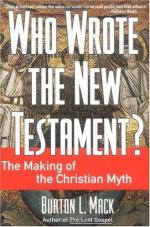|
This section contains 440 words (approx. 2 pages at 400 words per page) |

|
Who Wrote the New Testament?: The Making of the Christian Myth Summary & Study Guide Description
Who Wrote the New Testament?: The Making of the Christian Myth Summary & Study Guide includes comprehensive information and analysis to help you understand the book. This study guide contains the following sections:
This detailed literature summary also contains Topics for Discussion and a Free Quiz on Who Wrote the New Testament?: The Making of the Christian Myth by Burton L. Mack.
"Who Wrote the New Testament?" is Burton Mack's examination of how a diverse group of writings from the earliest centuries of the Christian era were assembled into the supposedly coherent Christian Bible in use today. Mack traces the formation of various fictional mythologies that were created by the early Jesus movement and Christian congregations in response to the uncertain political and cultural times in which they lived.
Far from being a unified philosophical group, the early followers of Jesus and the first Christian congregations often held widely different beliefs regarding their place in both the Jewish tradition and the political world of the Roman Empire, Mack explains. These diverse movements produced their own interpretations of the teachings of Jesus and what was required of his followers.
Mack provides an overview of the development of the myth that Jesus was a divine being and the son of God that marks the transition of the early Jesus movements into Christianity. He then explains how these early Christians combined earlier sources of the teachings of Jesus with this new mythology to create new texts that supported this myth. As the church grew, a similar process took place as church leaders sought to establish their authority by creating the mythology of the 12 apostles charged with establishing the one true church. At the same time, the early Christians reinvent the Jewish traditions from which Christianity sprung, reinterpreting the Jewish texts as prophetic announcements of the coming Christ. Some of these early texts are included in the present New Testament, some are not.
Very few of the books of the present New Testament can be shown to have been written by any one person by the name that is ascribed to them, Mack explains. Attribution took place long after the appearance of most of the texts, after the mythology of the 12 apostles was in place. Mack charts a probable chronological order and geographical location for these books, based on how much is borrowed from other texts.
It is when Constantine, the eastern Emperor of Rome, converts to Christianity that the modern Christian Bible begins to take form. As the new official state religion, a standard text is required along with the establishment of holy days and feasts. Eventually this approved set of writings was translated into Latin and it is this text that forms the basis for the modern Bible.
Mack concludes by challenging the taboo that he feels exists about questioning the traditional thinking about the Bible that is dominated by the Christian interpretation. He calls for an open and scholarly discussion of the book and its role in American culture.
Read more from the Study Guide
|
This section contains 440 words (approx. 2 pages at 400 words per page) |

|



